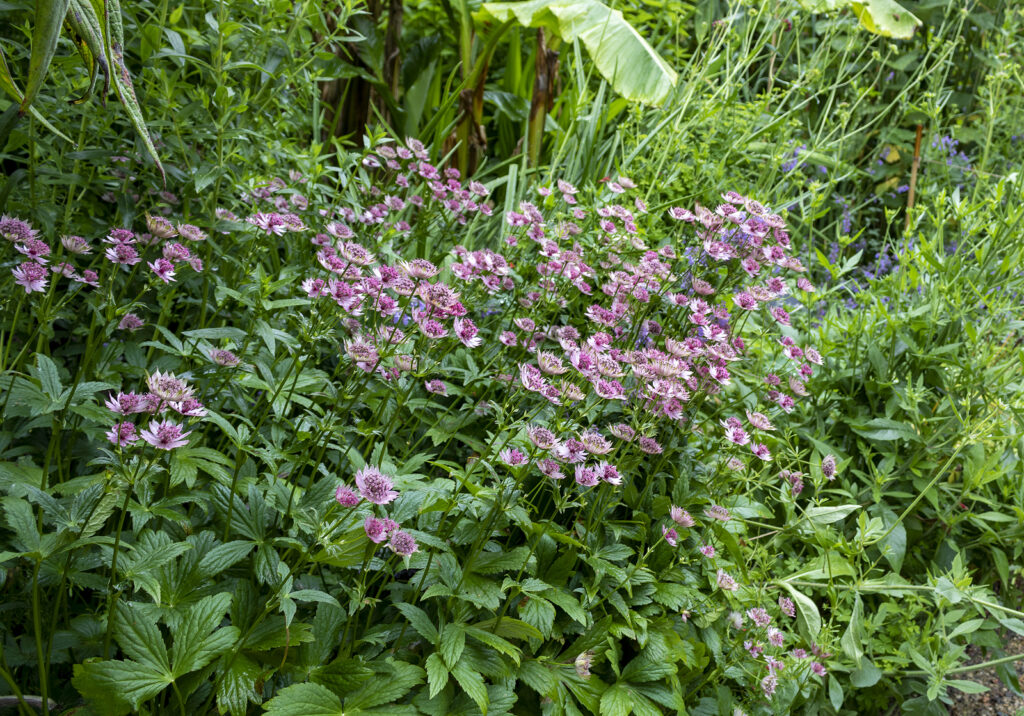Astrantia–commonly called masterwort–is a clump-forming perennial that bears buttonlike flowers. Each bloom consists of an umbel of small, tightly packed, five-petaled flowers surrounded by a showy ruff of papery, petal-like bracts.
Astrantia flowers are borne on branched stems above loose mounds of lobed leaves. Flowers can be green or pink, occasionally deep purple-red. Astrantia grows best in sun or partial shade. Plant Astrantia in humus-rich well-drained soil.
Astrantia is a genus of about 10 species native to alpine woods and meadows from Europe to West Asia.

Get to know Astrantia
- Plant type: Perennials
- Growing zones and range: Zones 4 to 7
- Hardiness: Hardy to Zone 4
- Height and width: 12 to 36 inches (30-90cm) tall and 18 inches (45cm) wide
- Growth rate: Slow
- Form and habit: Dense clump, spreading by rhizomes
- Foliage: Branched stems above loose mounds of leaves that are cut or lobed in a palmate fashion
- Flowers: White, pink, and rose five-petaled flowers are domed clusters on wiry, branched stems; small, papery bracts resemble pincushions, or, superficially, daisies
- Bloom time: Midsummer
- Uses: Cottage garden, woodland garden, along ponds or streams
- Common name: Masterwort
- Botanical name: Astrantia
- Family name: Apiaceae (Umbelliferae)
- Origin: Cool, alpine woods, and meadows in Europe and Asia
Where to plant Astrantia
- Plant Astrantia in half to full sun.
- Plant Astrantia in rich, well-drained loam with plenty of organic matter.
- Astrantia require cool night temperatures for best performance.
When to plant Astrantia
- If planting Astrantia near ponds or streams, plant crown above the water table.
Planting and spacing Astrantia
- For fruit production, grow one male Actinidia for every few females, or plant a self-fertile cultivar.
How to water and feed Astrantia
- Keep Astrantia average to continuously moist; plants do not tolerate drought or hot summer nights.
- Feed Astrantia with an all-purpose organic fertilizer in spring; give 50 percent more fertilizer than for average perennials.
How to care for Astrantia
- Deadhead Astrantia for prolonged and repeat bloom.
- Cut back foliage in late fall or early spring to avoid leaf spot.
Astrantia pests and diseases
- Astrantia are pest-free, but protect them from rabbits and woodchucks.
Astrantia propagation
- If not deadheaded, Astrantia will self-sow but not to nuisance levels.
- Astrantia rarely need division.
- Propagate Astrantia by division in spring or by seeds.
Astrantia varieties to grow
- Astrantia carniolica, to 15-18 inch (38.1-46.7cm) tall, with finely divided leaves. Bracts around flower heads shorter than other species. ‘Rubra’ has dark red flowers with silvery accents.
- A. Major, Masterwort, ‘Primadonna’, 1-3 foot (.3-.9m) tall perennial producing 1.5 foot (.5m) wide mounds of attractive leaves with five to seven toothed lobes. The .8-1.3 inch (2-3.3cm) wide umbels of flowers come in green, pink, or sometimes purplish red and have a ruff of green-veined white bracts beneath them. Blooms early to midsummer. ‘Hadspen Blood’ bears marroon bracts and flowers. ‘Sunningdale Variegated’ bears pink flowers and leaves edged in creamy yellow that fades to green. Zones 4 to 7.
- A. Maxima, slightly larger than A. major, with pink flowers.
- ‘Alba’ produces 2 foot .6m white flowers.
- ‘Lars’ is a vigorous variety with dark red flowers.















